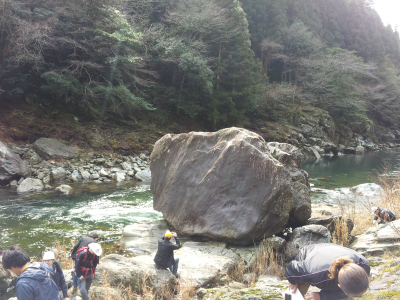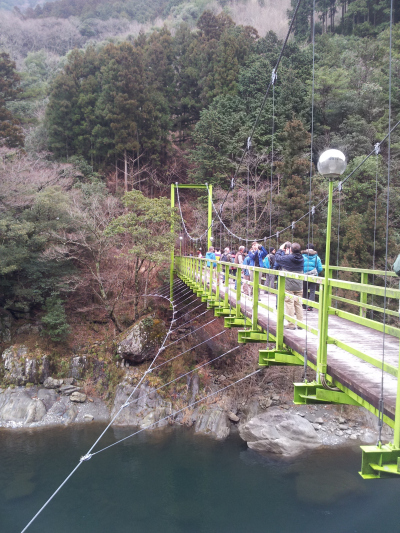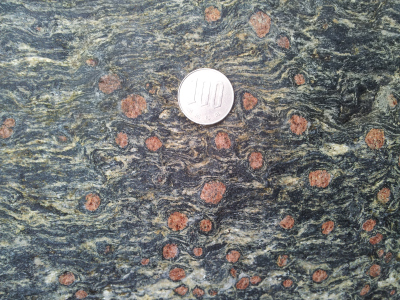Die Inhalte dieser Seite sind leider nicht auf Deutsch verfügbar.
Seitenpfad:
- Startseite
- ...
- Graduate School GLOMAR
- Travel Reports
- Conference Reports
- Archive
- Conference Reports 2012
- Sebastian Hammerschmidt
Bremen International Graduate School for Marine Sciences
Sebastian Hammerschmidt
Report of GLOMAR PhD student Sebastian Hammerschmidt about his participation in the International Conference on a New Perspective of Great Earthquakes Along Subduction Zones, Kochi City, Japan, 28 February - 1 March 2012
This year, the “International Conference on a New Perspective of Great Earthquakes Along Subduction Zones” was held for the first time. It took place in Kochi City, one of the main cities on Shikoku Island, SW Japan. The conference was joined by almost 150 scientists, who mainly participated either in the IODP NanTroSEIZE (NANkai TROugh SEIsmogenic Zone Experiment) and/or in the Japanese KANAME¹ (KAkenhi for NAnkai Megathrust Earthquakes) project, with the main subject being subduction zone processes and their subsequent role for the triggering of earthquakes. Both KANAME and NanTroSEIZE are focussing on the Nankai Trough, SE Japan, and subsequently, talks and posters about this study area were dominating the conference. In addition to that, some presentations were also dealing with the Japan Trench, where the disastrous Tohoku 2011 M9 earthquake occurred, and with upcoming expeditions like the this year’s fast-response-drilling project J-FAST.
Thanks to the support by the German Research Foundation (DFG-Grant-Nr. KO2108/8-1) I was able to attend the meeting and to contribute by presenting two posters, one as first author presenting Mini-CORK borehole observatories, and one as co-author, showing our plans to install and test the latest Mini-CORK, the MeBo-CORK, into a mud volcanoe within the Kumano forearc basin, north of the Nankai Trough. The poster session allowed us to introduce the scientific NanTroSEIZE and KANAME community to Mini-CORKs and their potential role as alternative to the common IODP CORK in-depth multilevel monitoring systems as well as presenting first results of the most rudimentary Mini-CORK, the SmartPlug. This resulted in fruitful discussions and definitely raised the popularity of the new systems. At the same time, colleagues from the Japan Agency for Marine-Earth Science and Technology (JAMSTEC) and the University of Japan presented new results from mud and pore water analysis from cores originating from the Kumano basin mud volcanoe field, which will improve the understanding of the upcoming long-term data from the MeBo-CORKs.
The poster session was well complemented by the oral session, where the most recent findings in NanTroSEIZE, KANAME and related projects were presented. A highlight was definitely the talk given by Christopher Spiers from the Universtiy of Utrecht, who showed that the velocity-weakening behaviour of illite-rich fault gouge as we can expect it at the Nankai Trough is, under in situ conditions, highly dependend on slip velocity, temperature, pore fluid pressure, normal stress and quartz content.
In addition to the poster and oral sessions, the conference included a highly interesting 1.5 days lasting excursion to the Tei Mélange (a tectonic mélange), to the Kochi Core Center as well as to the metamorphic succession of the Sanbagawa Belt in the northern part of Shikoku Island.
Thanks to Gaku Kimura and Asuka Yamaguchi from the University of Tokyo, we were also able to sample paleo-accretionary prisms of the Shimanto Belt during a three-days lasting field trip prior to the conference. We not only got a highly interesting insight into the geology (which was well explained by G. Kimura and A. Yamaguchi), but also in the Japanese culture during our stays in the small local hostels.
Overall these 8 days were very interesting and constructive, and I am really looking forward to the next “International Conference on a New Perspective of Great Earthquakes Along Subduction Zones “, which might be held in almost two years.
¹ kaname-ishi is also the stone which holds down the earthquake inducing namazu, i.e. a giant catfish living inside the earth
Thanks to the support by the German Research Foundation (DFG-Grant-Nr. KO2108/8-1) I was able to attend the meeting and to contribute by presenting two posters, one as first author presenting Mini-CORK borehole observatories, and one as co-author, showing our plans to install and test the latest Mini-CORK, the MeBo-CORK, into a mud volcanoe within the Kumano forearc basin, north of the Nankai Trough. The poster session allowed us to introduce the scientific NanTroSEIZE and KANAME community to Mini-CORKs and their potential role as alternative to the common IODP CORK in-depth multilevel monitoring systems as well as presenting first results of the most rudimentary Mini-CORK, the SmartPlug. This resulted in fruitful discussions and definitely raised the popularity of the new systems. At the same time, colleagues from the Japan Agency for Marine-Earth Science and Technology (JAMSTEC) and the University of Japan presented new results from mud and pore water analysis from cores originating from the Kumano basin mud volcanoe field, which will improve the understanding of the upcoming long-term data from the MeBo-CORKs.
The poster session was well complemented by the oral session, where the most recent findings in NanTroSEIZE, KANAME and related projects were presented. A highlight was definitely the talk given by Christopher Spiers from the Universtiy of Utrecht, who showed that the velocity-weakening behaviour of illite-rich fault gouge as we can expect it at the Nankai Trough is, under in situ conditions, highly dependend on slip velocity, temperature, pore fluid pressure, normal stress and quartz content.
In addition to the poster and oral sessions, the conference included a highly interesting 1.5 days lasting excursion to the Tei Mélange (a tectonic mélange), to the Kochi Core Center as well as to the metamorphic succession of the Sanbagawa Belt in the northern part of Shikoku Island.
Thanks to Gaku Kimura and Asuka Yamaguchi from the University of Tokyo, we were also able to sample paleo-accretionary prisms of the Shimanto Belt during a three-days lasting field trip prior to the conference. We not only got a highly interesting insight into the geology (which was well explained by G. Kimura and A. Yamaguchi), but also in the Japanese culture during our stays in the small local hostels.
Overall these 8 days were very interesting and constructive, and I am really looking forward to the next “International Conference on a New Perspective of Great Earthquakes Along Subduction Zones “, which might be held in almost two years.
¹ kaname-ishi is also the stone which holds down the earthquake inducing namazu, i.e. a giant catfish living inside the earth





